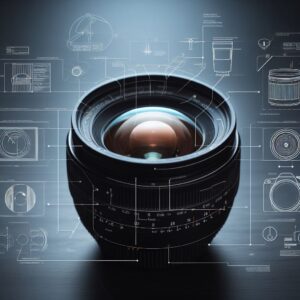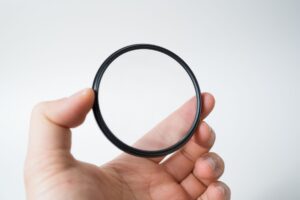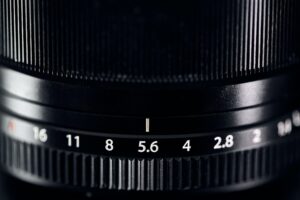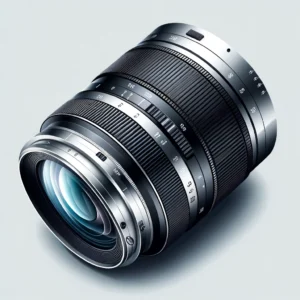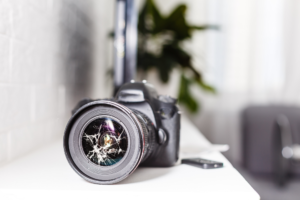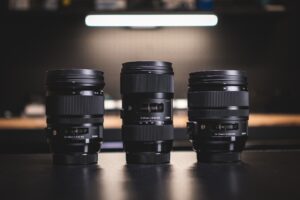The “Mirrorless vs. DSLR Lenses” debate is one that photographers—both beginners and experts alike—often find themselves embroiled in.
Making the right choice can significantly impact your photography experience, from handling and ergonomics to image quality and functionality.
Both systems have their merits and drawbacks, and the best choice largely depends on your specific needs and what you find most comfortable to work with.
Reasons to Keep Reading
- Understand the differences in camera design and handling between DSLR and mirrorless systems.
- Learn how sensor technology and image quality are fairly comparable in both setups.
- Discover the unique approaches to viewfinder technology in DSLRs and mirrorless cameras.
- Explore the advancements in autofocus systems in mirrorless cameras.
- Evaluate size and portability advantages and trade-offs.
- Get an insight into the lens selection for both systems.
- See how video capabilities differ between DSLR and mirrorless cameras.
- Understand the battery life implications of choosing one over the other.
- Learn about sensor dust management in both systems.
| Topic | Brief Description |
|---|---|
| Camera Design and Handling | Physical differences between DSLR and mirrorless cameras affecting user experience and ergonomics. |
| Sensor Technology and Image Quality | Both DSLRs and mirrorless cameras offer similar sensor technology, making the choice less significant for image quality. |
| Viewfinder Technology | Comparison between optical viewfinders in DSLRs and electronic viewfinders in mirrorless cameras. |
| Autofocus Systems | DSLRs use dedicated phase-detect sensors while mirrorless cameras utilize on-sensor autofocus technology. |
| Size and Portability | Mirrorless cameras are generally more compact but may have trade-offs like shorter battery life. |
| Lens Selection | Availability and flexibility of lens choices for both DSLR and mirrorless systems. |
| Video Capabilities | Mirrorless cameras often offer advanced video features compared to DSLRs. |
| Battery Life | Smaller size in mirrorless cameras often means shorter battery life. |
| Sensor Dust | Mirrorless sensors are easier to clean but are more exposed to dust. |
Camera Design and Handling
Understanding the physical design of DSLR and mirrorless cameras is crucial for every photographer, especially beginners.
The design directly impacts functionality, user experience, and ergonomics, influencing how you interact with the camera and ultimately how you capture images.
DSLR Design
Digital Single-Lens Reflex (DSLR) cameras have a more traditional design that includes a mirror mechanism and an optical viewfinder.
Light passes through the lens and is reflected by a mirror up into the viewfinder, allowing you to see exactly what the lens sees.
Advantages:
- Sturdy Build: Often weather-sealed and designed for more robust use.
- Better Grip: Provides a more substantial grip, particularly beneficial when using larger lenses.
- Familiar Feel: For those who have used film cameras, the DSLR will feel familiar.
Disadvantages:
- Heavier: The additional mirror and prism system add to the weight.
- Bulky: Larger size makes it less ideal for travel or discreet photography.
Mirrorless Design
Mirrorless cameras eliminate the mirror mechanism altogether, making them lighter and more compact.
They utilize either the rear LCD screen or an electronic viewfinder (EVF) for composing images.
Advantages:
- Compact: Generally lighter and easier to carry.
- Simpler Mechanism: Fewer moving parts mean less potential for mechanical failure.
- Real-time Exposure: Live exposure, depth of field, and depth of color can be previewed.
Disadvantages:
- Smaller Grip: May be less comfortable for extended use, especially when using larger lenses.
- Less Robust: Generally not as rugged as their DSLR counterparts, although newer models are closing the gap.
Note: Understanding the mechanics behind lenses can offer more context on how they fit into the overall design and ergonomics of DSLR and mirrorless cameras. For an in-depth look, read our article on How Do Camera Lenses Work.
Impact on User Experience and Ergonomics
When we talk about user experience and ergonomics, the differences between DSLR and mirrorless cameras come into sharper focus.
Handling and Grip
The DSLR’s substantial build offers a more robust grip, which can be beneficial when using larger, heavier lenses.
This could provide greater stability and comfort during prolonged shooting sessions.
Mirrorless cameras, with their more compact design, may offer less grip and could feel less stable when used with larger lenses.
Portability
Mirrorless cameras are generally more portable and easier to handle, particularly beneficial for those who travel frequently or prefer a lighter load.
DSLRs, being bulkier, are less convenient for on-the-go photography.
User Interface
DSLRs often come with a more complex array of buttons and dials, which might appeal to users who prefer tactile controls.
Mirrorless cameras, however, often feature simpler interfaces and touchscreen controls, which could be more intuitive for beginners or those used to smartphones.
Viewfinder Experience
DSLRs use optical viewfinders that offer a direct optical view through the lens, thanks to the mirror mechanism.
Mirrorless cameras, on the other hand, use electronic viewfinders or just the digital screen for composing shots.
The choice between these viewfinder technologies could significantly impact how you compose and capture images.
Each type of camera offers a unique set of advantages and disadvantages when it comes to design and handling.
Your specific needs—whether you prioritize a robust build, compact design, or specific user interface features—will guide your choice between DSLR and mirrorless.
Sensor Technology and Image Quality
When it comes to the core function of a camera—capturing light to create images—both DSLRs and mirrorless models employ similar sensor technologies.
Whether you choose a DSLR or a mirrorless camera, you’re likely to find comparable sensor sizes, from full-frame to APS-C and Micro Four Thirds.
These sensors are what truly influence the image quality, including factors like resolution, depth of field, and low-light performance.
Similarities in Image Quality
Both DSLRs and mirrorless cameras offer:
- High-resolution sensors: Capable of capturing a significant amount of detail.
- Wide dynamic range: Ability to capture both bright highlights and dark shadows.
- Low-light capabilities: Effective performance in various lighting conditions.
Choice and Final Image Quality
It’s crucial to understand that the choice between DSLR and mirrorless will not significantly affect the final image quality.
Advanced users may argue over the minutiae, but for most practical applications and especially for beginners, either will provide excellent image quality.
Viewfinder Technology
The type of viewfinder your camera has could affect your photography experience significantly.
Both DSLRs and mirrorless cameras have their unique approaches to viewfinder technology, each with its pros and cons.
Optical Viewfinders in DSLRs
Optical viewfinders are a hallmark of DSLR cameras.
They provide a direct optical view through the lens. When you look through an optical viewfinder, you’re seeing a real-time, optical view of your subject, unmediated by electronic components.
Pros:
- Zero Lag: What you see is happening in real-time.
- No Battery Drain: Using the optical viewfinder consumes less battery.
- Natural Look: Provides a more ‘true-to-life’ viewing experience.
Cons:
- Limited Information: Generally shows less shooting information.
- Parallax Error: What you see can slightly differ from what the sensor captures, although this is mostly negligible in modern DSLRs.
Electronic Viewfinders in Mirrorless Cameras
Mirrorless cameras typically employ electronic viewfinders (EVFs) or just use the rear LCD screen for composing shots.
Unlike optical viewfinders, electronic ones display a digital preview of the image as captured by the camera’s sensor.
Pros:
- Real-time Exposure Preview: You see a live preview, including changes to exposure, depth of field, and white balance.
- More Information: EVFs can display histograms, focus peaking, and other shooting aids.
- Digital Zoom: Helpful for manual focus.
Cons:
- Battery Drain: Consumes more battery compared to optical viewfinders.
- Lag: Some older or less advanced EVFs might have a noticeable lag, although this has improved significantly in newer models.
By understanding the differences between these viewfinder types, you can better align your camera choice with your preferences for composing and previewing images.
Whether you prefer the immediate, ‘true-to-life’ feel of optical viewfinders, or the real-time digital feedback provided by electronic ones, will influence your decision between a DSLR and a mirrorless camera.
Autofocus Systems
One of the pivotal features that often tip the balance in the DSLR vs. mirrorless conversation is the autofocus system.
Both systems have their unique approaches, with DSLRs using dedicated phase-detection sensors and mirrorless cameras often relying on on-sensor autofocus technology.
DSLR Autofocus System
In a DSLR, the autofocus system generally uses dedicated phase-detection sensors that are separate from the image sensor.
These sensors are typically located in the mirror assembly.
Pros:
- Fast for Stills: Especially effective when the mirror is down and the camera is set for still photography.
- Mature Technology: Has been around for a longer time, and is reliable for most types of photography.
Cons:
- Limited Coverage: Usually covers a smaller area in the middle of the frame.
- Inconsistent in Live View: When using the screen instead of the viewfinder (Live View), autofocus can be slow and less accurate.
Mirrorless Autofocus System
Mirrorless cameras often use on-sensor phase detection or contrast detection for autofocus.
This allows for a more versatile AF system that covers a larger area of the frame.
Pros:
- Fast and Accurate: Modern systems are very quick and cover a large portion of the frame.
- Eye Tracking: Advanced systems offer eye and face tracking, even for animals.
Cons:
- Battery Drain: More sophisticated AF systems can consume more power, reducing battery life.
- Less Established for Certain Types of Photography: Though catching up fast, it is not as established as DSLR systems for some specialized photography.
Note: The effectiveness of autofocus can also depend on the type of lens you use. To make the most of your existing kit lens in terms of autofocus, read our tips on How to Make the Most of Your Kit Lens.
Advancements in Mirrorless Autofocus Technology
Mirrorless autofocus technology has seen significant advancements in recent years.
Features like real-time tracking, eye autofocus, and AI-enhanced subject recognition are changing the game, offering accuracy and speed that even outperform many DSLRs.
| Aspect | DSLR Autofocus | Mirrorless Autofocus |
|---|---|---|
| Technology | Dedicated phase-detection sensors | On-sensor phase/contrast detection |
| Speed | Fast for stills | Generally fast and accurate |
| Coverage | Limited area coverage | Wider area coverage |
| Advancements | Mature but fewer recent breakthroughs | Rapid advancements like eye-tracking |
Size and Portability
Mirrorless cameras win hands down in terms of size and portability, thanks to their compact design.
This makes them ideal companions for travel photographers or anyone who prefers a lighter load.
Advantages of Compact Size
- Ease of Travel: Easier to pack and carry around.
- Discreet Photography: Less obtrusive, making it easier to capture candid shots.
Potential Trade-offs
However, this advantage comes with its own set of trade-offs:
- Battery Life: Smaller bodies mean smaller batteries, which might require you to carry extras.
- Handling Larger Lenses: A compact body may feel unbalanced with larger lenses, affecting ergonomics.
Note: If you’re wondering how the size and weight of a lens will impact your shooting experience, our article on What Camera Lens Do I Need will guide you through the lens selection process based on your specific needs.
Lens Selection
When it comes to lens selection, both DSLRs and mirrorless cameras offer a broad range of options. However, each comes with its distinct advantages and disadvantages.
Lens Choices for DSLRs
DSLRs, especially from established brands like Canon, Nikon, and Sony, have a rich ecosystem of lenses developed over many years.
You can find a DSLR lens for almost any specialized type of photography, from macro to wildlife to astrophotography.
Pros:
- Wide Variety: From budget to professional lenses, the choices are numerous.
- Availability: Due to a longer market presence, used lenses are easier to find.
- Compatibility: Older lenses can often be used on newer camera bodies, sometimes requiring an adapter.
Cons:
- Size and Weight: DSLR lenses are generally bigger and heavier, reflecting the camera’s own dimensions.
Note: Lens type, be it zoom or prime, is another crucial factor in your decision-making process. For a detailed comparison, check out Zoom Lenses vs Prime Lenses. If you’re considering buying second-hand lenses, our article Should I Buy Used Camera Lenses could be invaluable.
Advantages of Modern Mirrorless Lenses
Mirrorless lenses have seen rapid advancements, and new lens mounts offer unprecedented flexibility and performance benefits.
Pros:
- Innovative Features: Faster autofocus, image stabilization, and advanced optics.
- Compact Design: Generally smaller and lighter than their DSLR counterparts.
- Flexibility: Newer mounts are designed for maximum compatibility, including with older lenses via adapters.
Cons:
- Cost: Being newer technology, some advanced mirrorless lenses can be expensive.
- Limited Second-hand Market: Less availability in the used market compared to DSLRs.
| Aspect | DSLR Lenses | Mirrorless Lenses |
|---|---|---|
| Variety | Extensive | Growing fast |
| Innovation | More traditional | Often include advanced features |
| Size and Weight | Generally larger and heavier | More compact and lighter |
| Cost | Wide range, including budget options | Newer technology can be expensive |
Video Capabilities
When it comes to video capabilities, mirrorless cameras generally have a significant edge over DSLRs.
Advantages of Mirrorless for Video
- 4K and Higher Resolutions: Most new mirrorless cameras support high-definition video recording.
- Better Autofocus: On-sensor autofocus technologies are more reliable for video.
- Flexibility: Features like log profiles and higher frame rates for slow-motion are more common.
DSLRs and Video
While DSLRs can shoot video and often do it quite well, they generally lack the advanced video features of their mirrorless competitors.
- Limited Autofocus: Many DSLRs struggle with autofocus in video mode.
- Fewer Features: DSLRs may not offer as many frame rate options or high-end video features like log profiles.
Battery Life
Battery life is an important factor to consider when choosing between DSLRs and mirrorless cameras, as it can greatly impact your shooting experience.
DSLR Battery Life
DSLR cameras generally offer longer battery life for a few reasons:
- Optical Viewfinder: Consumes less power compared to the electronic viewfinders in mirrorless cameras.
- Fewer Electronics: DSLRs often have fewer electronic components that require constant power.
Mirrorless Battery Life
On the other hand, mirrorless cameras usually have shorter battery life, mostly due to:
- Electronic Viewfinder and Screen: These consume more power, affecting overall battery life.
- Compact Size: Smaller batteries fit into mirrorless cameras, offering less capacity.
| Aspect | DSLR Cameras | Mirrorless Cameras |
|---|---|---|
| Battery Life | Generally longer | Generally shorter |
| Power Drain | Lower due to fewer electronics | Higher due to more electronics |
Sensor Dust
Sensor dust can be a minor annoyance or a significant issue, depending on your shooting conditions.
DSLRs and Sensor Dust
In a DSLR, the mirror and shutter mechanisms offer some protection to the sensor, making it less exposed to dust.
Mirrorless and Sensor Dust
Mirrorless cameras lack this physical barrier, making the sensor more exposed. However, cleaning a mirrorless sensor is generally easier because of the absence of the mirror and shutter mechanisms.
Note: Keeping your sensor and lens clean is vital for optimal image quality. Learn how to safely clean your camera lens in our article How Do You Clean a Camera Lens.
FAQs
Is One Superior: Mirrorless Lenses or DSLR Lenses?
Mirrorless lenses aren’t necessarily better than DSLR lenses. The choice depends on your specific photography needs and what you find comfortable to work with.
Can the Same Lenses Be Used for Both DSLR and Mirrorless?
No, mirrorless and DSLR cameras usually require different lens mounts. However, some adapters allow for cross-compatibility.
What’s the Photographer’s Choice: DSLR or Mirrorless?
There’s no definitive answer as it varies from photographer to photographer. Some prefer the lightweight design of mirrorless, while others stick to DSLRs for their optical viewfinders.
How Do Mirrorless Lenses Differ from DSLR Lenses?
Mirrorless lenses are generally more compact and can offer faster autofocus speeds due to technological advancements in mirrorless cameras.
What Makes Photographers Choose DSLR over Mirrorless?
Some photographers prefer DSLRs for their longer battery life, wider lens selection, and because they’re used to the DSLR system.
Why Might Mirrorless Cameras Produce Sharper Images?
Mirrorless cameras may offer sharper images due to advancements in on-sensor autofocus technology and the absence of a mirror mechanism.
Do Professional Photographers Use Mirrorless Cameras?
Yes, many professional photographers have adopted mirrorless cameras due to their compact size, lighter weight, and advanced features.
Are There Any Advantages to Using a DSLR?
DSLRs often have better battery life, a more extensive range of lenses, and some photographers prefer their optical viewfinders.
Are Special Lenses Required for Mirrorless Cameras?
No, you don’t need special lenses for mirrorless cameras, but you do need lenses that are compatible with your camera’s specific mount.
Which Camera Type Tends to Last Longer: DSLR or Mirrorless?
Both types are durable if cared for properly, but DSLRs may have a slight edge due to fewer electronic components.
What Does the Future Hold: DSLR or Mirrorless?
The industry is increasingly moving towards mirrorless technology, but DSLRs continue to hold a significant market share.
Is Investing in a DSLR Wise in 2023?
If you have a specific reason for preferring DSLRs, such as existing lenses or familiarity, then a DSLR can still be a good investment in 2023.
Why Do Individuals Opt for Mirrorless Cameras?
People often choose mirrorless cameras for their compact size, lighter weight, and more advanced video capabilities.
Conclusion
Choosing between a DSLR and a mirrorless camera is a significant decision that will influence your photography journey.
Both types have their pros and cons, from design and handling to sensor technology, viewfinder differences, and battery life.
- If you value a traditional shooting experience and longer battery life, a DSLR might be more your style.
- If you prefer a compact, technologically advanced camera with high-quality video features, then mirrorless could be the way to go.
In the end, your choice should align with your specific needs, preferences, and the kind of photography you want to pursue.
Take the time to weigh all these factors to make an informed decision that will satisfy you for years to come.



